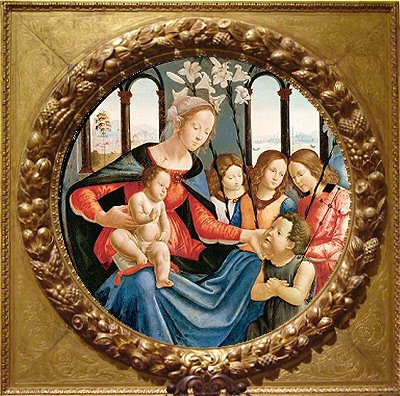 |
|
Madonna and Child with Saint John and Three Angels
Painter: Sebastiano Mainardi
Tour Presentation by Lin Vertefeuille April 23, 2000
Right away you can see this painting is very different from the others -
it's round! A round painting is called a tondo. This tondo was painted about the
year 1500. In Italy at that time, the circle had special meaning and was thought to
represent eternity, heavenly harmony and perfection. We can tell the artist planned this
painting to be round and didn't just place it into a circular frame. Let's examine it.
Notice the arrangement of the people if we move: from the woman's face - to her right arm
- across the folds of her gown - to the standing child - then up to the youth on the far
right, who is inclining his head back to the woman's face. This configuration of figures
creates a circular pattern that was carefully designed by the artist. |
Now let's look more closely at the people. We see a mother dressed in
period clothing holding a child in her lap while she gently caresses the cheek of a child
standing next to her. We can tell easily that she is not really a Renaissance matron with
children. The halos on their heads indicate to us that they are the Madonna, Christ Child
and young Saint John the Baptist. The three youths standing behind, who look like pages
are angels attending them. Very striking is the Madonna's serene and beautiful face. This
kind of remote and idealized beauty was popular in the Renaissance (particularly seen in
Fra Filippo Lippi and Botticelli). She motherly and tenderly caresses young Saint John's
cheeks. He responds to her touch by looking at her and the Christ Child with an expression
of pure pleasure and adoration. The interaction of these holy people (divine conversation)
is confined to themselves, doesn't try to involve us in what's happening and keeps us as
an observer. This is characteristic of Renaissance paintings. However, in this painting
their interaction is very human, understandable and appealing to us.
There are religious symbols in the painting that would have meaning to a person in the
1500's. The lilies stand for the Virgin's purity, the cross held by Saint John the Baptist
suggests Christ's future death and the pomegranate seeds held in the Christ Child's hand
symbolizes the resurrection and the unity of the church.
The background in the painting viewed through the arched windows is perplexing. The scene
on the right is a canal in Venice. It is curious that the artist who did most of his work
in Florence and San Gimignano, painted a scene in Venice. Perhaps his audience and patrons
were Venetian. The scene on the left with hills and a town is open to interpretation. The
landscape could represent the hills of Tuscany. However, there are some curious aspects
when we examine it closely. In the distance you can barely discern a person riding a
donkey with another figure walking behind it. It has been speculated that this scene
represents Jerusalem or Bethlehem and the holy family's flight to Egypt.
This painting was so popular, that the artist and his studio made five variants, or
copies, each slightly different, but the distant figures-with-donkey are unique to our
painting.
Also special to this painting is this magnificent frame - it's gilded, carved wood covered
with gold. The impressive tondo portion was made around 1500 and is thought to be original
with this oil on panel painting. The gilded square outer frame was added later, possibly
late 1800's.
The painting is called Madonna and Child with Saint John and Three Angels by the
artist Domenico
Ghirlandaio (and his workshop). A favorite painter of the Medici, who was well known in Florence and
painted frescoes in the Sistine Chapel in Rome. By the way, Michelangelo, when he was thirteen years old, apprenticed in
Ghirlandaio's studio.
|
